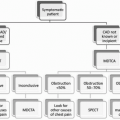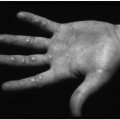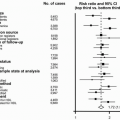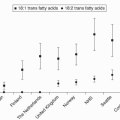Dyslipidemia and Atherosclerosis in Women
Christian D. Nagy
Catherine Y. Campbell
Roger S. Blumenthal
Cardiovascular disease (CVD) remains the number one killer of American women and coronary heart disease (CHD) accounts for more than half of cardiovascular deaths (1). The underrepresentation of women in clinical trials has led to a general misconception that coronary artery disease (CAD) was mostly a disease of men. On average, women develop coronary atherosclerosis a decade later than men do. Although death rates from CVD are declining, more women die of CVD than their male counterparts, perhaps due in part to delayed diagnosis and the fact that women generally develop CVD at an older age when they have more comorbidities (2).
THEORETICAL CONSIDERATIONS
Development of Atherosclerosis and CVD in Women
While mechanisms to induce CVD are similar in both genders, there are differences in the anatomy and physiology of the myocardium; moreover, sex hormones modify the course of disease in women. Clinicians have long been aware of the apparent “protection” of younger, premenopausal women, an advantage that has been attributed to the effects of endogenous estrogen. Coronary atherosclerosis is a process that starts early in life as described in detail in Chapter 12. Despite the incremental close correlation between traditional risk factors and extent of atherosclerotic involvement in childhood, young women tend to have a lesser degree of atherosclerosis than their age-matched peers. In adulthood, women also have less coronary calcification than men. Generally, coronary calcification increases with age. Women, however, lag behind men in terms of amounts of coronary calcium by about 10 to 15 years.
Women have smaller coronary arteries than men as evidenced by angiographic and coronary ultrasound analysis; however, the remodeling process leading to atherosclerotic plaque formation seems to be similar in both sexes. Analysis of gender differences in plaque composition revealed a lesser degree of calcification in women than in men. Autopsy studies performed in individuals who died more than 1 year after coronary artery bypass graft surgery found women to have greater amounts of cellular fibrous tissue and less dense fibrous tissue in both native coronary arteries and saphenous vein grafts, but similar amounts of intracellular lipid and degree of inflammatory infiltration. Other genetic differences are present in endothelial function (estrogen-induced coronary vasodilation) and hemostasis (higher fibrinogen and factor VII level in women).
Plaque morphology and coronary atherosclerosis heterogeneity are typically not taken into account in clinical studies relating risk factors and CVD in women. Whereas the common final pathway in all patients presenting with acute myocardial infarction (MI) is usually thrombotic coronary occlusion, the triggers may be different in women as compared to men. One autopsy series found that women had more plaque erosion (37% vs. 18%), whereas men had more plaque rupture (82% vs. 63%).
Another autopsy study compared coronary plaque morphology in 51 women who died of sudden cardiac death (mean age 50 ± 12 years) and 15 women who died of noncoronary deaths (mean age 50 ± 19 years). Compared to control subjects, women with plaque ruptures had elevated total cholesterol (TC) (270 ± 55 mg/dL vs. 194 ± 44 mg/dL, p = 0.02), those with erosions were more likely to be smokers (78% vs. 33%, p = 0.01), and women with stable plaque and healed infarct had elevated glycosylated hemoglobin (10.2 ± 5.0% vs. 6.4 ± 0.4%, p = 0.01) and were more likely to be hypertensive (50% vs. 15%, p = 0.03).
Multivariate risk analysis performed in all these women revealed cigarette smoking to be associated with plaque erosion (p = 0.03, odds ratio [OR] 21), glycosylated hemoglobin with stable plaque and healed infarct (p = 0.03, OR 41), higher TC with plaque rupture (p = 0.02, OR 7), and hypertension with stable plaque and healed infarct (p = 0.02, OR 15). Furthermore, plaque erosion with acute coronary thrombosis was more common among younger (presumably premenopausal) women, whereas plaque rupture with superimposed thrombus or healed infarct without thrombosis was more common among older (presumably postmenopausal) women. Given that the mechanisms of sudden cardiac death differ in younger women as compared to older women, risk factor modification may be most effective if targeted to the most common mechanisms of plaque instability.
Recognized risk factors for development of atherosclerosis such as diet and obesity, body fat distribution, diabetes mellitus and metabolic syndrome, physical inactivity, cigarette smoking, hypertension, dyslipidemia, inflammation, and a family history of premature CVD are similar in both genders. They often present together producing congruent effects. As compared to men, women with unstable angina and non STelevation myocardial infarction (NSTEMI) are older, less frequently of white race, and have a higher incidence of diabetes and hypertension. Subsequent paragraphs will provide a brief overview of the risk factors for atherosclerosis in women.
Obesity and Body Fat Distribution in Women
Obesity (body mass index [BMI] > 30) and sedentary lifestyle have been linked to increased risk of CHD in men and women. The prevalence of obesity has increased over the last few decades (3). About 30% to 40% of adult women are estimated to be obese. The Nurses’ Health Study revealed a sevenfold higher CVD mortality in the heaviest women, and the Framingham Offspring Study demonstrated a dramatic increase in cardiovascular risk factors at BMI > 20. Being overweight and obese is associated with significant decreases in life expectancy; 40-year-old female nonsmokers and 40-year-old male nonsmokers lost 3 years of life expectancy because of overweight status. In 40-year-old nonsmokers, females lost 7 years and males lost 6 years because of obesity. Obese female smokers and obese male smokers lost 7 years compared with normal-weight nonsmokers.
Obesity is linked to elevated C-reactive protein (CRP) and other inflammatory markers, especially in women (see also Chapter 15). In a recent prospective study, the metabolic syndrome, but not BMI, predicted future cardiovascular risk in women. There are better measures of obesity other than BMI. The pattern of fat distribution, particularly abdominal fat accumulation, is an important predictor for the development of type 2 diabetes mellitus, hypertriglyceridemia, hypertension, and CVD. The waist-to-hip ratio and waist circumference have been independently associated with risk of CVD in women. A waist-to-hip ratio >0.88 and waist circumference >38 inches is predictive of a substantially increased risk of CVD events among women.
Diabetes Mellitus in Women
Diabetes mellitus (DM) is a more significant risk factor for the presence and severity of CHD in women than in men; 10% of Americans ≥20 years of age have DM and 21 % of Americans ≥60 years of age have DM. While men ≥20 years of age have a slightly higher prevalence of DM (11%) than women (9%), the “female gender advantage” appears to be offset by an increasing incidence of obesity and diabetes. Type 2 DM is associated with obesity, abdominal body fat distribution, hypertension, atherogenic dyslipidemia, and insulin resistance, which are all known related factors for increased CHD risk. DM also promotes endothelial dysfunction and platelet abnormalities.
More than in men, DM substantially increases the mortality of MI in women. In a contemporary meta-analysis, the relative risk of coronary death from DM was 2.58 (95% confidence interval [CI] 2.05 to 3.26) for women and 1.85 (95% CI 1.47 to 2.33) for men (p = 0.045) (4). Racial differences may affect the role of DM as a risk factor for developing CAD in women. The CHD incidence associated with a medical history of DM has been calculated at 9% in African-American women, compared to 6% in American women of European descent.
Physical Inactivity in Women
Regular brisk physical activity most days of the week promotes a healthy lifestyle. Physical inactivity is more prevalent among women than men; however, there are some differences. Hispanic and African-American women are generally the least physically active. There is a strong negative correlation between physical activity and coronary events in women independent of other CVD risk factors. Barriers to lack of exercise include caregiver duties, low energy, and absence of peers seen exercising.
Smoking in Women
Cigarette smoking results in more deaths from CHD and stroke than from any other cause. More than 50% of MIs among middle-aged women are attributable to tobacco. Female smokers are at a six- to ninefold increased risk of developing MI and stroke than nonsmokers. Accelerated atherosclerosis and a predilection to vascular thrombosis are responsible for most of the harmful cardiovascular effects of smoking. “Second-hand smoking” also increases the risk of heart disease in women.
Hypertension in Women
One in three U.S. adults has high blood pressure (HBP). A higher percentage of men than women have HBP until 45 years of age. Between 45 and 54 years of age, the percentages of men and women with HBP are similar. After that, a much higher percentage of women have HBP than do men (3). HBP is two to three times more common in women taking oral contraceptives, especially in obese and older women, than in those not taking them. From 1988-1994 to 1999-2002, the prevalence of HBP in adults increased from 36% to 41% among blacks and was particularly high among black women (44%). The prevalence among whites also increased from 24% to 28% and was 30% in white women. A strong association between elevated blood pressure (systolic and diastolic) and risk of CHD has been established in epidemiologic studies in both genders.
After adjusting for other risk factors, 29% of CHD events in women were attributable to blood pressure levels higher than 130/85 mm Hg. The 2004 overall U.S. death rate (per year per 100,000 population) from HBP was 18.1. Death rates were 16 for white males, 51 for black males, 14.5 for white females, and 41 for black females (5). Although women have fewer CVD events, the population risk attributable to hypertension is higher for women than for men because of the increased incidence with age and superior longevity of women. Numerous risk factors and markers for development of hypertension have been identified, including age, ethnicity, family history of hypertension and genetic factors, lower education and socioeconomic status, greater weight, lower physical activity, psychosocial stressors, sleep apnea, and dietary factors (including dietary fats, higher sodium intake, lower potassium intake, and excessive alcohol intake).
Dyslipidemia in Women
Lipid levels in women are influenced by hormonal changes throughout life as outlined in more detail throughout the next section. Women, and predominantly those older than 65 years, demonstrate a weak association of levels of elevated TC and low-density lipoprotein cholesterol (LDL-C) with CHD (6). However, high-density lipoprotein cholesterol (HDL-C) levels are closely and inversely associated with CHD risk in women.
Triglycerides (TG) are an independent predictor of CAD in older women (6). HDL-C and TG appear to be more closely related to CHD risk among women than men, whereas LDL-C appears to be a more potent predictor among men.
Triglycerides (TG) are an independent predictor of CAD in older women (6). HDL-C and TG appear to be more closely related to CHD risk among women than men, whereas LDL-C appears to be a more potent predictor among men.
Non-HDL cholesterol (non-HDL-C) appears to be a better measure of CHD risk in women than in men. An increased level of apolipoprotein B-100 (apoB) is also associated with higher cardiac risk in women. Each of the atherogenic lipoprotein particles contains a single molecule of apoB and therefore the concentration of apoB reflects the total number of circulating atherogenic apoB-containing lipoproteins, including very low density lipoprotein (VLDL), intermediate density lipoprotein (IDL), and Lp(a) lipoprotein [Lp(a)] (see also Chapters 1 and 16). ApoB is a better predictor of the number of LDL particles than LDL-C. Smaller than average LDL particle size and LDL pattern B are associated with the development of premature CHD in younger women, even after LDL-C and other risk factors are taken into account; however, the association is not independent of HDL-C, TG, and BMI.
Additionally, Lp(a) is associated with higher cardiac risk in women. Lp(a) consists of an LDL particle with its apoB-100 molecule linked by a disulfide bridge to apo(a). Apo(a) is a glycoprotein homologous to plasminogen with a yet uncertain biologic function. The molecular weight of apo(a) varies considerably depending on the number of repeats of the kringle 4 region (see also Chapter 18). In the Framingham Study, elevated Lp(a) levels in women strongly predicted incident MI and also correlated with claudication and development of cerebrovascular disease. Elevated Lp(a) strongly predicts recurrent events among women with CHD.
Among obese women and women with the metabolic syndrome or DM, there are often associated adverse changes in the lipid profile. There is a greater prevalence of the dyslipidemic triad consisting of LDL phenotype B (predominance of small, dense LDL), lower HDL-C levels, and higher TG levels. Adverse lipoprotein changes associated with DM tend to be more pronounced in women than in men and may account for the worse prognostic impact of DM on cardiovascular health among women.
Inflammation in Women
There is a close relationship between inflammation and cardiovascular risk. Serum levels of high-sensitivity C-reactive protein (hsCRP) have been found to be a better predictor of CAD than LDL-C levels in younger and older women (see also Chapter 15). HsCRP values are generally higher in women than in men across all ethnic groups. Serum hsCRP provides additional prognostic information to female patients with the metabolic syndrome. Additional inflammatory markers such as tumor necrosis factor-α receptor levels, serum A amyloid, and plasma fibrinogen levels have been linked to excess risk of CVD in women.
Psychological Factors in Women
Psychological factors like stress and depression predispose to increased cardiovascular risk in both genders. Work-related stress such as job strain (often due to increased work demands and decreased job control) and effort-reward imbalance (reflecting economic factors) can double the risk for MI and stroke. Perceived stress in general and lack of situational control have also been found to increase the risk of CHD. Clinical depression has been identified to be a strong predictor of CHD in a contemporary meta-analysis. Although depression often coexists with other known risk factors, its detrimental effects on overall cardiovascular risk remain even after adjusting for traditional risk factors, supporting depression as an independent predictor of events.
Genetics of CVD and Atherosclerosis in Women
Hereditary factors besides common risk factors are essential when CAD is expressed, especially in younger women. There is ample evidence that MI tends to cluster in families. Since some of the major documented risk factors for development of CVD have important genetic determinants themselves (i.e., DM, hypertension, hypercholesterolemia), the question arises whether occurrences of MI are due to familial aggregation of these risk factors or to genetic and/or environmental determinants shared by family members, which exert their effects through yet unknown mechanisms.
In several studies, a family history of MI or CHD was shown to be a strong predictor of CHD, even after adjustment for other risk factors. A family history of MI is positively associated with the risk of early MI in women. In a population-based case-control study among 18- to 44-year-old American females, the rate of MI among first-degree relatives of MI cases was twice as high as among first-degree relatives of controls (relative risk [RR], 1.96; 95% CI, 1.46 to 2.48). After controlling for established CHD risk factors, a sibling history of MI but not parental history was associated with early development of heart attacks. In a subsample further adjustment for lipids, lipoproteins, and specific genetic risk factors slightly reduced the association with sibling MI history (from OR, 5.17; 95% CI, 1.93 to 13.85 to OR, 3.97; 95% CI, 0.92 to 17.17), but the correlation still remained strong.
The genetics of CHD is currently being studied in the context of gene polymorphisms (see also Chapter 17). In the future gene polymorphisms may provide a better understanding of the development of CHD among susceptible women, particularly those with a family history of heart disease. Variability in risk due to genetic factors has also been supported by recent data showing a strong correlation between genetic markers (single-nucleotide polymorphisms or SNPs) at a locus on chromosome 9 and CHD. Genome-wide association scanning identified a 58-kb interval on chromosome 9p21 that was consistently associated with CHD in six independent samples (more than 23,000 participants) from four Caucasian populations. This interval, which is located near the CDKN2A and CDKN2B genes, contains no annotated genes and is not associated with established CHD risk factors such as plasma lipoproteins, hypertension, or DM. Homozygotes for the risk allele make up 20% to 25% of Caucasians and have a ˜30% to 40% increased risk of CHD.
HORMONAL MILIEU AND LIPIDS
Lipid levels vary throughout the lifespan of a woman and are influenced by hormonal changes. Prior to puberty the average lipid profile is similar in girls and boys (7). Young women have lower LDL-C cholesterol and non-HDL-C but higher HDL-C
than men of similar age. The reverse is true after menopause. An increase in the number of small, dense LDL particles occurs after menopause. However, compared to men, LDL particle number remains lower in women throughout their lifetime. Corresponding to the age-related increase in LDL-C in women, mean Lp(a) also increases about twofold (from 10 to 20 mg/dL) after menopause, whereas Lp(a) levels remain constant in males (see also Chapter 18).
than men of similar age. The reverse is true after menopause. An increase in the number of small, dense LDL particles occurs after menopause. However, compared to men, LDL particle number remains lower in women throughout their lifetime. Corresponding to the age-related increase in LDL-C in women, mean Lp(a) also increases about twofold (from 10 to 20 mg/dL) after menopause, whereas Lp(a) levels remain constant in males (see also Chapter 18).
Gender differences in HDL-C levels and HDL particle size emerge at puberty with the rise in endogenous testosterone levels and concomitant HDL decline in males. Over their lifespan, women exhibit a higher average HDL-C level than men by about 10 mg/dL. A substantial proportion (20%) of women with CVD have HDL-C levels of ≥60 mg/dL, which is considered “protective” against CVD development. Gender differences in HDL-C and CVD risk may reflect either a deleterious effect of testosterone in men or a protective effect of estrogen in premenopausal women, or both.
Hormonal influences on lipoprotein levels in women are diverse (8). Before menopause, lipid values vary throughout the menstrual cycle. Parous women tend to have lower HDL-C levels than nulliparous women. Effects of different contraceptives vary in their composition and administration route. They mainly include elevations in TG accompanied by a decrease in LDL particle size, whereas LDL-C and HDL-C are less affected. After menopause, TC levels increase. LDL-C tends to rise and LDL particle distribution shifts toward smaller, denser particles. Mean HDL-C levels remain unchanged. Postmenopausal women tend to have a greater postprandial rise of lipoprotein levels after a standardized fat meal than premenopausal women despite a similar post-heparin lipoprotein lipase activity. Differences in the metabolism of chylomicrons and large chylomicron remnants have been postulated.
Pleotropic Effects of Estrogen
Beyond the effects on lipids, estrogen can have both positive and negative effects on the cardiovascular system (9). Estrogen facilitates nitric oxide-mediated vasodilation and inhibits the response of blood vessels to injury and the development of atherosclerosis. However, estrogens increase inflammatory markers such as CRP and have prothrombotic effects, increasing circulating levels of prothrombin and decreasing antithrombin III, and consequently contributing to an increased risk of venous thromboembolic events.
Notably, many of these effects of estrogen are mediated by first-pass effects through the liver and thus result from oral but not transdermal administration. For example, increased levels of CRP seem to occur only with oral estrogen administration. The extent to which this is associated with an increase in CVD risk is uncertain. The mode of administration may have potential importance regarding the overall effects of hormone therapy (HT) on CHD risk.
Estrogen Effects in Atherosclerotic Arteries
The effects of estrogen on the vasculature seem to depend at least in part on the extent to which atherosclerosis has become established. Estrogen receptor expression is markedly diminished in atherosclerotic arteries, thus reducing potential receptordependent effects on the vasculature and antiatherosclerotic benefits. Depending on the state of health of the underlying vessel, the effects of estrogen on a given pathway may have different consequences.
Matrix Metalloproteinases (MMP)
For example, estrogen upregulates specific members of the MMP family such as MMP-9. MMP degrade the extracellular matrix within the arterial wall. In a nondiseased artery, an estrogen-induced increase in MMP-9 may have little or no consequences, whereas in an atherosclerotic artery, where MMP-9 is expressed in the shoulder region of an atherosclerotic plaque, an increase in MMP-9 activity could be associated with an increased risk of plaque rupture and thus acute coronary syndromes.
Estrogen Receptor (ER)
The effects of estrogen are largely mediated through its interaction with the ER (10). The ER is a member of the nuclear hormone family of intracellular receptors which is activated by the hormone 17β-estradiol. The main function of the ER is as a DNA-binding transcription factor which regulates gene expression (genomic effects). However, the ER also has additional functions independent of DNA binding (nongenomic effects). There are two different forms of the ER (ERα and ERβ), each encoded by a separate gene (ESR1 on chromosome 6 and ESR2 on chromosome 14). Each ER can be subdivided in six distinct functional regions.
Both ERs are widely expressed in different tissue types and are present in human heart. Selective ER modulators preferentially bind to either the α- or β-subtype of the receptor. Additionally, the different ER combinations may respond differently to various ligands. As a consequence, the same ligand may be an agonist in some tissue, while antagonistic in other tissues. Since estrogen is a steroidal hormone it can pass through the phospholipid membranes of the cell; receptors, therefore, do not need to be membrane bound in order to bind with estrogen. Some ERs associate with the cell surface membrane and can be rapidly activated by exposure of cells to estrogen. Some ER may associate with cell membranes and form complexes with G proteins, striatin, receptor tyrosine kinases, and nonreceptor tyrosine kinases.
The mechanisms mediating the nongenomic effects of estrogen on the cardiovascular system are not fully understood; however, current knowledge suggests involvement of enhanced nitric oxide release, effects on calcium handling, and regulation of potassium currents. The genomic effects of estrogen on the cardiovascular system are due to changes in cardiomyocytes gene expression mediated by ERα and ERβ. The identity and effects of these target genes remain to be uncovered.
EFFECTS OF HORMONE THERAPY
Lipid and Lipoprotein Levels
The protective effect of estrogen in premenopausal women against CVD events stimulated interest in the use of hormone replacement therapy (HT) as a putative preventive measure against atherosclerotic heart disease. Observational studies documented decreased cardiac event rates in postmenopausal women
receiving hormone replacement therapy and hypotheses generated advocating its use seemed reasonable (11). Oral postmenopausal HT decreases LDL-C and Lp(a) levels, increases HDL-C and TG levels, and is associated with improved glucose tolerance and reductions in weight and waist circumference (12).
receiving hormone replacement therapy and hypotheses generated advocating its use seemed reasonable (11). Oral postmenopausal HT decreases LDL-C and Lp(a) levels, increases HDL-C and TG levels, and is associated with improved glucose tolerance and reductions in weight and waist circumference (12).
The rise in TG is most pronounced with estrogen monotherapy and might be associated with adverse changes in LDL particle size and atherogenicity. Although progestin therapy tends to blunt this TG rise, it also blunts the rise in HDL-C associated with oral estrogen supplementation. ER polymorphisms have been found to influence the HDL-C response to hormone replacement therapy. Lipoprotein effects generally are attenuated with use of lower-dose formulations.
While initially promising, changes in lipid profiles with hormone replacement therapy have not translated into improved CVD outcomes. On the contrary, randomized controlled trials have provided evidence of increased CVD risk, especially in the first year after initiating therapy, combined with increased risk of breast cancer, thromboembolic disease, and stroke, resulting in a marked revision of prior recommendations (2,12). Long-term transdermal estrogen supplementation therapy might result in LDL-C lowering without significantly affecting HDL-C and TG. Selective ER modulators have less pronounced effects on the lipid profile than oral HT. Raloxifene was found to decrease LDL-C by ˜9%, increase TG by up to 1.5%, and had no effect on HDL-C; however, it did not significantly affect the risk of CHD.
On the first look, these recent trials have provided us with somewhat unexpected results. To better understand their findings, we will analyze the most important ones in more detail. The major studies are summarized in Table 13.1.
Effects of Observational Studies
A series of observational and case-control trials of hormone replacement suggested benefits toward reduction in CHD events with nonsignificant trends (OR ranging from 0.69 to 0.9). A larger case-control study showed a significant association with HT and reduced incidence of first MI (13), and longer duration use seemed to confer an even greater cardiovascular benefit.
Nurses’ Health Study (NHS)
The NHS (11,14,15) was a prospective, observational cohort study to investigate duration, dose, and type of postmenopausal HT and primary prevention of CVD. Over 70,000 postmenopausal women participated, in whom 1,258 major coronary events (nonfatal MI or fatal coronary disease) and 767 strokes were identified over a period of 20 years. Details of postmenopausal hormone use were documented by using biennial questionnaires.
CVD was established by using a questionnaire and was confirmed by medical record review. The risk for major coronary events was lower among users of HT, including short-term users, compared with never-users (RR, 0.61; 95% CI, 0.52 to 0.71). Among women taking oral conjugated estrogen, the risk for coronary events was similarly reduced in those who took 0.625 mg daily (RR, 0.54; CI, 0.44 to 0.67) and who took 0.3 mg daily (RR, 0.58; CI, 0.37 to 0.92) compared with never-users. However, the risk for stroke was statistically significantly increased among women taking ≥0.625 mg of oral conjugated estrogen daily (RR, 1.35; CI, 1.08 to 1.68 for 0.625 mg/day and RR, 1.63; CI, 1.18 to 2.26 for >1.25 mg/day) and those taking estrogen plus progestin (RR, 1.45; CI, 1.10 to 1.92).
Overall, little relation was observed between combination HT and risk for CVD (major CHD plus stroke) (RR, 0.91; CI, 0.75 to 1.11). Investigators concluded that postmenopausal hormone use appeared to decrease risk for major coronary events in women without previous heart disease. Furthermore, 0.3 mg of oral conjugated estrogen daily was associated with a reduction similar to that seen with the standard dose of 0.625 mg. However, estrogen at daily doses of 0.625 mg or greater and in combination with progestin may increase the risk for stroke. Of note, most women in the NHS likely started taking HT in the perimenopausal period and were free of known CHD at the start of the study.
Heart and Estrogen/Progestin Replacement Study (HERS)
HERS (12,16) was a randomized, double-blind, placebo-controlled secondary prevention trial conducted to determine if estrogen and progesterone (medroxyprogesterone acetate) therapy changes the risk for CVD events (fatal or nonfatal MI) in postmenopausal women with established coronary disease. HERS included 2,763 women with established CHD such as a history of MI, coronary artery revascularization, or 50% occlusion of ≥1 major coronary arteries. Older postmenopausal women (mean age 67 years) with established CHD were randomly assigned to 0.625 mg CEE plus 2.5 mg MPA per day or placebo and followed on average for 4 years.
Stay updated, free articles. Join our Telegram channel

Full access? Get Clinical Tree








